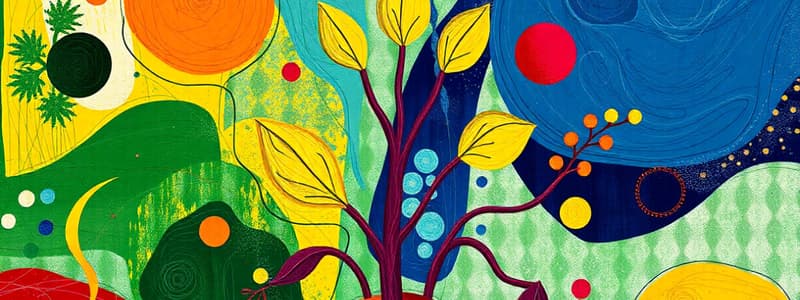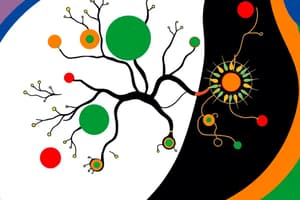Podcast
Questions and Answers
Which of the following is the most direct example of homeostasis?
Which of the following is the most direct example of homeostasis?
- Bacteria evolving resistance to antibiotics.
- A cell undergoing mitosis to repair damaged tissue.
- A plant growing taller in response to sunlight.
- A mammal maintaining a constant body temperature. (correct)
Which of the following best describes the relationship between the levels of biological organization?
Which of the following best describes the relationship between the levels of biological organization?
- Each level operates independently without influencing the others.
- The levels are arranged randomly, with no specific order or hierarchy.
- Lower levels dictate the function of higher levels without being affected in return.
- Higher levels are composed of multiple units of the level immediately below it, exhibiting emergent properties. (correct)
A scientist is studying a cell under a microscope, and observes that it contains a nucleus and membrane-bound organelles. This cell is most likely from a:
A scientist is studying a cell under a microscope, and observes that it contains a nucleus and membrane-bound organelles. This cell is most likely from a:
- Virus
- Archaeon
- Plant (correct)
- Bacterium
If a cell were unable to produce functional ribosomes, which of the following processes would be most directly affected?
If a cell were unable to produce functional ribosomes, which of the following processes would be most directly affected?
How does the cell membrane contribute to maintaining cellular homeostasis?
How does the cell membrane contribute to maintaining cellular homeostasis?
Which of the following is the primary role of enzymes in metabolic processes?
Which of the following is the primary role of enzymes in metabolic processes?
When ATP is hydrolyzed to ADP and inorganic phosphate, what occurs?
When ATP is hydrolyzed to ADP and inorganic phosphate, what occurs?
Which of the following cellular processes is directly responsible for converting light energy into chemical energy?
Which of the following cellular processes is directly responsible for converting light energy into chemical energy?
Which of the following is the primary function of mRNA?
Which of the following is the primary function of mRNA?
During which phase of cellular respiration is the majority of ATP produced?
During which phase of cellular respiration is the majority of ATP produced?
What is the role of DNA polymerase in DNA replication?
What is the role of DNA polymerase in DNA replication?
In Mendelian genetics, if a heterozygous individual (Aa) is crossed with a homozygous recessive individual (aa), what is the probability of producing offspring with the homozygous recessive genotype (aa)?
In Mendelian genetics, if a heterozygous individual (Aa) is crossed with a homozygous recessive individual (aa), what is the probability of producing offspring with the homozygous recessive genotype (aa)?
Which of the following is NOT a potential outcome of a mutation in a DNA sequence?
Which of the following is NOT a potential outcome of a mutation in a DNA sequence?
How does natural selection lead to evolution?
How does natural selection lead to evolution?
What is the primary difference between mitosis and meiosis?
What is the primary difference between mitosis and meiosis?
Which of the following exemplifies community ecology?
Which of the following exemplifies community ecology?
Which of the following levels of classification is the broadest (i.e., contains the most organisms)?
Which of the following levels of classification is the broadest (i.e., contains the most organisms)?
How does geographic isolation lead to speciation?
How does geographic isolation lead to speciation?
Flashcards
Biology
Biology
The scientific study of life.
Cell Theory
Cell Theory
All living organisms are composed of cells.
Gene Theory
Gene Theory
Traits are inherited through genes.
Homeostasis
Homeostasis
Signup and view all the flashcards
Growth
Growth
Signup and view all the flashcards
Cells
Cells
Signup and view all the flashcards
Nucleus
Nucleus
Signup and view all the flashcards
Mitochondria
Mitochondria
Signup and view all the flashcards
Photosynthesis
Photosynthesis
Signup and view all the flashcards
Cellular Respiration
Cellular Respiration
Signup and view all the flashcards
DNA Structure
DNA Structure
Signup and view all the flashcards
DNA Replication
DNA Replication
Signup and view all the flashcards
RNA Structure
RNA Structure
Signup and view all the flashcards
Protein Synthesis
Protein Synthesis
Signup and view all the flashcards
Genes and Inheritance
Genes and Inheritance
Signup and view all the flashcards
Evolution
Evolution
Signup and view all the flashcards
Natural Selection
Natural Selection
Signup and view all the flashcards
Taxonomy
Taxonomy
Signup and view all the flashcards
Study Notes
- Biology is the scientific study of life.
Core Principles of Biology
- Cell theory: all living organisms are composed of cells.
- Gene theory: traits are inherited through genes.
- Evolution: all life forms have evolved over time from a common ancestor.
- Homeostasis: maintenance of a stable internal environment.
- Thermodynamics: life processes involve energy transformations.
Characteristics of Life
- Organization: Living things exhibit complex organization.
- Metabolism: Living organisms carry out metabolic reactions.
- Reproduction: Living organisms reproduce to create new organisms.
- Growth: Increase in size or cell number.
- Response: Ability to detect and respond to stimuli.
- Adaptation: Evolving traits to suit their environment.
Levels of Biological Organization
- From smallest to largest: molecules, cells, tissues, organs, organ systems, organisms, populations, communities, ecosystems, and the biosphere.
- Each level builds upon the previous one and exhibits emergent properties.
Cell Structure and Function
- Cells are the basic units of life.
- Two main types: prokaryotic and eukaryotic.
- Prokaryotic cells lack a nucleus and other membrane-bound organelles (e.g., bacteria).
- Eukaryotic cells have a nucleus and other membrane-bound organelles (e.g., animal, plant, fungi, and protist cells).
Key Cellular Organelles and Functions
- Nucleus: Contains the cell's genetic material (DNA) and controls cell activities.
- Mitochondria: Generate energy (ATP) through cellular respiration.
- Ribosomes: Synthesize proteins.
- Endoplasmic reticulum (ER): Network of membranes involved in protein and lipid synthesis.
- Golgi apparatus: Modifies, sorts, and packages proteins and lipids.
- Lysosomes: Contain enzymes for breaking down cellular waste and debris.
Cell Membrane
- Selectively permeable barrier composed of a lipid bilayer with embedded proteins.
- Regulates the movement of substances into and out of the cell.
Cell Communication
- Cells communicate through chemical signals.
- Receptors receive signals and initiate cellular responses.
Metabolism and Enzymes
- Metabolism is the sum of all chemical reactions in an organism.
- Enzymes are biological catalysts that speed up chemical reactions.
- Enzymes are highly specific and bind to specific substrates.
Energy and ATP
- ATP (adenosine triphosphate) is the primary energy currency of the cell.
- Energy is released when ATP is hydrolyzed to ADP (adenosine diphosphate) and inorganic phosphate.
Photosynthesis
- Process by which plants and other organisms convert light energy into chemical energy.
- Occurs in chloroplasts.
- Involves two main stages: light-dependent reactions and the Calvin cycle.
Cellular Respiration
- Process by which cells break down glucose to generate ATP.
- Occurs in mitochondria.
- Three main stages: glycolysis, Krebs cycle (citric acid cycle), and electron transport chain.
DNA Structure and Function
- DNA (deoxyribonucleic acid) is the genetic material that carries hereditary information.
- Double helix structure composed of nucleotides.
- Nucleotides consist of a deoxyribose sugar, a phosphate group, and a nitrogenous base (adenine, guanine, cytosine, or thymine).
DNA Replication
- Process by which DNA is copied.
- DNA polymerase is the main enzyme involved.
- Results in two identical DNA molecules.
RNA Structure and Function
- RNA (ribonucleic acid) is involved in protein synthesis.
- Single-stranded structure composed of nucleotides.
- Nucleotides consist of a ribose sugar, a phosphate group, and a nitrogenous base (adenine, guanine, cytosine, or uracil).
- Main types of RNA: mRNA (messenger RNA), tRNA (transfer RNA), and rRNA (ribosomal RNA).
Protein Synthesis
- Two main stages: transcription and translation.
- Transcription: DNA is transcribed into mRNA in the nucleus.
- Translation: mRNA is translated into a protein by ribosomes in the cytoplasm.
Genes and Inheritance
- Genes are segments of DNA that code for proteins.
- Alleles are different versions of a gene.
- Genotype is the genetic makeup of an organism.
- Phenotype is the observable characteristics of an organism.
Mendelian Genetics
- Gregor Mendel's laws of inheritance: segregation and independent assortment.
- Punnett squares are used to predict the genotypes and phenotypes of offspring.
Chromosomes and Cell Division
- Chromosomes are structures that carry genetic information.
- Humans have 46 chromosomes (23 pairs).
- Mitosis: cell division that produces two identical daughter cells.
- Meiosis: cell division that produces four haploid gametes (sperm and egg cells).
Mutation
- Changes in the DNA sequence.
- Can be spontaneous or caused by mutagens.
- Can have no effect, a positive effect, or a negative effect on an organism.
Evolution
- Change in the genetic makeup of a population over time.
- Supported by evidence from fossils, comparative anatomy, embryology, and molecular biology.
Natural Selection
- Mechanism of evolution proposed by Charles Darwin.
- Individuals with advantageous traits are more likely to survive and reproduce.
Speciation
- Process by which new species arise.
- Can occur through geographic isolation or reproductive isolation.
Taxonomy and Classification
- Science of classifying organisms.
- Hierarchical system: domain, kingdom, phylum, class, order, family, genus, species.
Domains of Life
- Bacteria, Archaea, and Eukarya.
- Bacteria and Archaea are prokaryotic.
- Eukarya includes protists, fungi, plants, and animals.
Ecology
- Study of the interactions between organisms and their environment.
Population Ecology
- Study of the size, density, distribution, and dynamics of populations.
Community Ecology
- Study of the interactions between different species in a community.
Ecosystem Ecology
- Study of the flow of energy and cycling of nutrients in ecosystems.
Biomes
- Large geographic areas characterized by specific climate conditions and plant communities (e.g., tundra, taiga, temperate forest, grassland, desert, tropical rainforest).
Biodiversity
- Variety of life on Earth.
- Includes genetic diversity, species diversity, and ecosystem diversity.
Conservation Biology
- Study of the conservation of biodiversity.
- Addresses threats to biodiversity, such as habitat loss, pollution, and climate change.
Studying That Suits You
Use AI to generate personalized quizzes and flashcards to suit your learning preferences.




